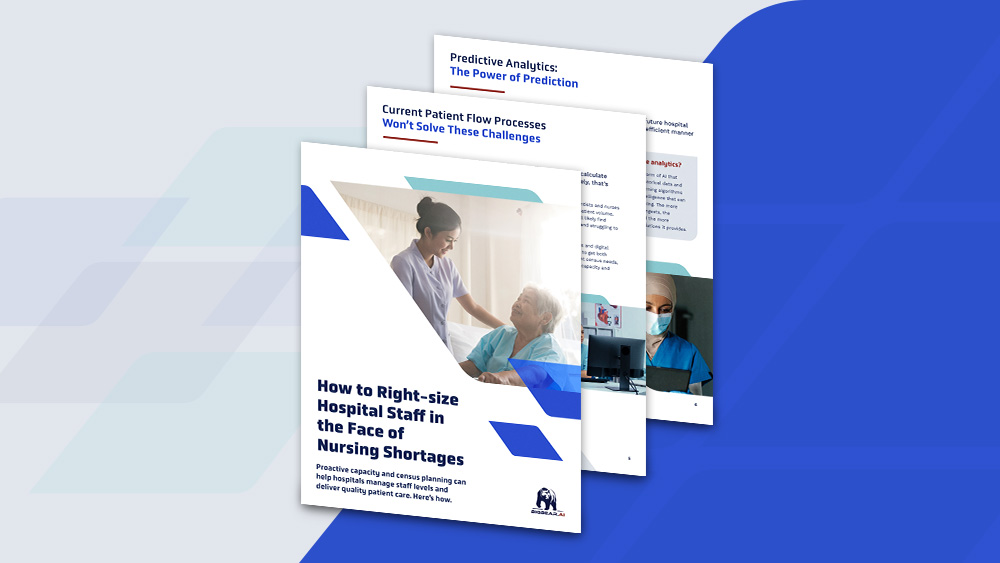How Machine Learning Can Help Hospitals Take the Guesswork Out of Capacity Planning
 Hospitals across the nation are facing an unpredictable census.
Hospitals across the nation are facing an unpredictable census.
In the face of a COVID-19, RSV, and flu “tripledemic” this winter, near crisis levels of nursing shortages (6.5 million individuals will leave their healthcare positions in the next five years), and an aging population, hospital administrators and practitioners are questioning their readiness to best care for an influx of patients.
Hospitals need to get their staffing and census right. That way, they can ensure they have the right beds, and the right nurses, to deliver the right care.
But with current technology and processes, that’s hard to achieve.
The problem with current patient flow processes
From beds to staff, resource and capacity planning is a perpetual challenge for hospitals. That’s because many hospitals still rely on manual census planning which can be susceptible to human error and is enormously time-consuming. Plus, it is often focused exclusively on short-term census planning – predicting which patients will move through the hospital and need services or beds within the next few hours.
Current methodologies, such as Monte Carlo simulations and other mathematical algorithm models, are also inadequate. They don’t consider all possible interdependencies and complexities of a hospital environment, especially when more and more systems and data points are involved.
Furthermore, these simulations ignore the impact of external influences on patient census. These include holiday periods and school vacations or unexpected implications of the COVID-19 pandemic, like the uptick in mental health-related emergency department visits by children.
Given these challenges, hospitals need access to tools that can help them accurately plan. They must be able to predict the seasonal and demographic trends that impact demand and capacity – today, next week, and months ahead.
For this they need machine learning (ML).
Using machine learning to transform capacity planning
With an ML strategy, hospitals can get both real-time information on current census needs and proactively plan for future capacity and staffing.
ML works by taking raw, historical data (in this case, anonymized data from historical and present patient electronic health records) and applies algorithms to provide actionable intelligence that informs census planning.
The data is used to compile information such as the conditions patients present, their demographics, how they move through a hospital, and their length of stay.
For example, when ML is combined with the power of predictive analytics and What if Scenario Analysis (WISA), it can inform different levels of impact (i.e., “What if the next COVID-19 wave creates a 15% jump in our census? How do we staff accordingly to meet that surge?”) and prescribe an action. Hospitals can then plan staffing levels and bed count for the most likely case – and prepare for the worst possible outcomes.
In this way, ML takes the data hospitals have and gives them answers to what they don’t currently know, taking away uncertainty and replacing it with knowledge and assuredness.
Continuously learning for smarter decision-making
The power of ML lies in the fact that it continually learns. The more information the system ingests, the smarter it becomes and the more accurate the recommendations it provides, such as a staff mix or schedule, patient routes, etc.
Importantly, these real-time insights can be achieved even in the face of resource constraints and hiring challenges in data science. With that being said, ML only works when these tools are trained on accurate, timely, and complete data based on actual patient information and external influences – not assumptions. After all, the output of an algorithm is only as good as its input. Or as the adage says: “garbage in garbage out.”
Granular predictions improve care orchestration
By using ML and predictive analytics, administrators and nurse planners can slice and dice data at an unprecedented level of granularity, including the health issues patients present with and the units they are admitted to. With these insights, they can more accurately and proactively predict census and care orchestration – down to the unit and level of specialized care.
And, as ML-powered solutions evolve, they can begin to consider variables, including seasonal ebbs and flows (such as holidays) and external influences (including pandemics and natural disasters), and how they relate to hospital admissions day-by-day, hour-by-hour. Using this data, administrators and planners can predict surge needs and its impact on emergency admissions, surgeries, and bed count – helping improve capacity planning and right-sizing of staffing.
For example, a nurse manager could filter the data to look at possible census scenarios from September to February. They can see how their hospital’s census is likely to fluctuate based on the fall and winter seasons when viruses are more likely to be prominent and prepare accordingly, weeks and months ahead.
Then, using a technology called digital twins, and a process called discrete event simulation (DES), ML data can be visualized to show patient movements throughout a hospital, helping drive process improvement.
Powering the right decisions when it matters most
Demand for hospitals is exceeding capacity. And the situation is only expected to get worse. Many hospitals simply do not have enough room to house growing numbers of patients. Yet traditional ways of forecasting capacity can result in a wrong read on the census.
But hospitals can be prepared. If they apply ML to historic and real-time data, they can study trends and patterns and then apply predictive analytics to inform the future state. They can learn what resources they need to treat patients effectively and where to right size hospital staffing. Plus, staff will no longer be continuously playing catch-up, and fewer decisions will be based on guesswork.
At the same time, hospitals will gain significant efficiencies. They will save money by being able to accurately plan and map out resource needs in advance.
The Right Capacity Planning for your Hospital System – Learn more
FutureFlow Rx® creates a digital twin of your hospital or hospital system that uses predictive analytics to provide the right resources when and where you need them most. Learn more about our Machine Learning solutions for your healthcare environment and explore more how ML can be used for capacity planning and operational improvement to address various census-impacting scenarios. Download our whitepapers:



